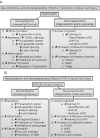Tamoxifen and Src kinase inhibitors as neuroprotective/neuroregenerative drugs after spinal cord injury
- PMID: 25878585
- PMCID: PMC4396099
- DOI: 10.4103/1673-5374.153685
Tamoxifen and Src kinase inhibitors as neuroprotective/neuroregenerative drugs after spinal cord injury
Abstract
Spinal cord injury (SCI) is a devastating condition that produces significant changes in the lifestyle of patients. Many molecular and cellular events are triggered after the initial physical impact to the cord. Two major phases have been described in the field of SCI: an acute phase and late phase. Most of the therapeutic strategies are focused on the late phase because this provides an opportunity to target cellular events like apoptosis, demyelination, scar formation and axonal outgrowth. In this mini-review, we will focus on two agents (tamoxifen and a Src kinase family inhibitor known as PP2) that have been shown in our laboratory to produce neuroprotective (increase cell survival) and/or regenerative (axonal outgrowth) actions. The animal model used in our laboratory is adult female rat (~250 g) with a moderate contusion (12.5 mm) to the spinal cord at the T10 level, using the MASCIS impactor device. Tamoxifen or PP2 was administered by implantation of a 15 mg pellet (Innovative Research of America, Sarasota, FL, USA) or by intraperitoneal injections (1.5 mg/kg, every 3 days), respectively, to produce a long-term effect (28 days). Tamoxifen and the Src kinase inhibitor, PP2, are drugs that in rats with a moderate spinal cord injury promote functional locomotor recovery, increase spared white matter tissue, and stimulate axonal outgrowth. Moreover, tamoxifen reduces the formation of reactive oxygen species. Therefore, these drugs are possible therapeutic agents that have a neuroprotective/regenerative activity in vertebrates with SCI.
Keywords: PP2; Src kinase; neuroprotection; regeneration; tamoxifen; trauma.
Conflict of interest statement
Figures


Similar articles
-
Tamoxifen Administration Immediately or 24 Hours after Spinal Cord Injury Improves Locomotor Recovery and Reduces Secondary Damage in Female Rats.J Neurotrauma. 2016 Sep 15;33(18):1696-708. doi: 10.1089/neu.2015.4111. Epub 2016 Apr 8. J Neurotrauma. 2016. PMID: 26896212 Free PMC article.
-
Long-term treatment with PP2 after spinal cord injury resulted in functional locomotor recovery and increased spared tissue.Neural Regen Res. 2014 Dec 15;9(24):2164-73. doi: 10.4103/1673-5374.147949. Neural Regen Res. 2014. PMID: 25657738 Free PMC article.
-
Tamoxifen: an FDA approved drug with neuroprotective effects for spinal cord injury recovery.Neural Regen Res. 2016 Aug;11(8):1208-11. doi: 10.4103/1673-5374.189164. Neural Regen Res. 2016. PMID: 27651756 Free PMC article. Review.
-
Tamoxifen attenuates inflammatory-mediated damage and improves functional outcome after spinal cord injury in rats.J Neurochem. 2009 Jun;109(6):1658-67. doi: 10.1111/j.1471-4159.2009.06077.x. Epub 2009 Mar 30. J Neurochem. 2009. PMID: 19457130
-
Traumatic Spinal Cord Injury-Repair and Regeneration.Neurosurgery. 2017 Mar 1;80(3S):S9-S22. doi: 10.1093/neuros/nyw080. Neurosurgery. 2017. PMID: 28350947 Review.
Cited by
-
Honokiol exerts protective effects on neural myelin sheaths after compressed spinal cord injury by inhibiting oligodendrocyte apoptosis through regulation of ER-mitochondrial interactions.J Spinal Cord Med. 2022 Jul;45(4):595-604. doi: 10.1080/10790268.2021.1890878. Epub 2021 Apr 8. J Spinal Cord Med. 2022. PMID: 33830903 Free PMC article.
-
The Role of Estrogen Receptors and Their Signaling across Psychiatric Disorders.Int J Mol Sci. 2020 Dec 31;22(1):373. doi: 10.3390/ijms22010373. Int J Mol Sci. 2020. PMID: 33396472 Free PMC article. Review.
-
Translational Significance of Selective Estrogen Receptor Modulators in Psychiatric Disorders.Int J Endocrinol. 2018 Oct 8;2018:9516592. doi: 10.1155/2018/9516592. eCollection 2018. Int J Endocrinol. 2018. PMID: 30402099 Free PMC article. Review.
-
Elucidation of the mechanism of Zhenbao pills for the treatment of spinal cord injury by network pharmacology and molecular docking: A review.Medicine (Baltimore). 2024 Feb 16;103(7):e36970. doi: 10.1097/MD.0000000000036970. Medicine (Baltimore). 2024. PMID: 38363936 Free PMC article. Review.
-
Tamoxifen Administration Immediately or 24 Hours after Spinal Cord Injury Improves Locomotor Recovery and Reduces Secondary Damage in Female Rats.J Neurotrauma. 2016 Sep 15;33(18):1696-708. doi: 10.1089/neu.2015.4111. Epub 2016 Apr 8. J Neurotrauma. 2016. PMID: 26896212 Free PMC article.
References
-
- Akiyama C, Yuguchi T, Nishio M, Fujinaka T, Taniguchi M, Nakajima Y, Yoshimine T. Src family kinase inhibitor PP1 improves motor function by reducing edema after spinal cord contusion in rats. Acta Neurochir Suppl. 2003;86:421–423. - PubMed
-
- Akiyama C, Yuguchi T, Nishio M, Tomishima T, Fujinaka T, Taniguchi M, Nakajima Y, Kohmura E, Yoshimine T. Src family kinase inhibitor PP1 reduces secondary damage after spinal cord compression in rats. J Neurotrauma. 2004;21:923–931. - PubMed
-
- Ardizzone TD, Zhan X, Ander BP, Sharp FR. SRC kinase inhibition improves acute outcomes after experimental intracerebral hemorrhage. Stroke. 2007;38:1621–1625. - PubMed
-
- Arevalo MA, Diz-Chaves Y, Santos-Galindo M, Bellini MJ, Garcia-Segura LM. Selective oestrogen receptor modulators decrease the inflammatory response of glial cells. J Neuroendocrinol. 2011;24:183–190. - PubMed
-
- Arevalo MA, Santos-Galindo M, Bellini MJ, Azcoitia I, Garcia-Segura LM. Actions of estrogens on glial cells: Implications for neuroprotection. Biochimic et Biophys Acta. 2010;1800:1106–1112. - PubMed
Publication types
Grants and funding
LinkOut - more resources
Full Text Sources
Other Literature Sources
Research Materials
Miscellaneous
